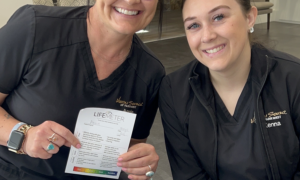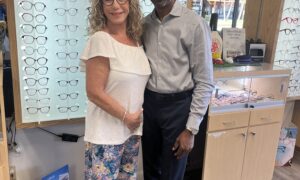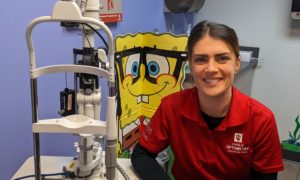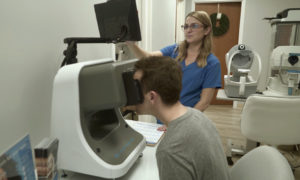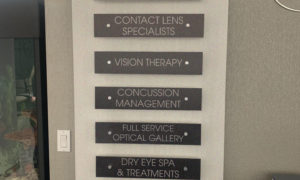Sponsored Content

By Dave Anderson, OD
Feb. 10, 2021
A patient’s insurance dictates a lot about the experience they have with a provider. Often, that leaves practice owners with an insufficient say in patient satisfaction.
When a bad experience happens in an OD’s office as a result of a vision plan, it is challenging to convey the issue clearly to patients. For example, it may take weeks or months to receive a completed job from a lab or the job will be completed in a manner that cannot be given to a patient.
That reflects poorly on the office since the office’s employees are the ones passing along the message to the patient about these difficulties. The patient’s entire experience can be ruined because of the barriers to timely and accurate patient care and products that are in place mostly to maximize profit for the vision plan.
The Right Tool For The Job
It was for those reasons that a few years ago we introduced technology from Anagram to our practice. This technology has given us freedom from managed care, and enhanced our ability to be better, more profitable providers of care.
Anagram is a cloud-based web application that provides a streamlined experience for managing vision insurance benefits for all kinds of eyecare providers, including optometrists, opticians and ophthalmologists. It’s as easy for our staff as obtaining the patient’s insurance member information, logging onto Anagram, seeing the patient’s benefits information appear on the screen and creating a claim for the services and product purchases. The process takes no more than around one minute per patient.
Better Care, Patient Experience & Profitability
The impact on both our ability to increase access to our services, and on our profitability, was almost instantaneous. One metric I looked at before deciding to add Anagram to our practice was average patient revenue with a vision plan versus those without a vision plan. I saw that we would only need to retain 10 percent of patients with vision plans to ensure no loss in revenue if we dropped vision plans from our practice. It turns out I was right–and then some. With no change at all in our capture rate with these retained patients, we were able to increase our overall revenue well over 10 percent in the first several months after implementing Anagram.
In addition, we are able to spend more time with patients without worrying about how their insurance will reimburse us. The patients pay us in full, and then Anagram allows us to easily file a request on their behalf for reimbursement, so that it is the patient, rather than our office, that is getting reimbursed by the insurance company.
Gain Freedom from Limitations of Managed Care
Vision plans restrict practice owners’ abilities to provide quality care to patients in several ways. Most of the time, they either force the doctor to use a specific lab, often owned by the vision plan, and/or force them to use products owned and designed by the vision plans. This restricts the doctor from choosing a higher-quality lab, a lab that may return jobs more efficiently, or a product that is better suited for a patient than what is available under the “allowed” options.
Ensuring access to better jobs was just one of many ways I was able to improve patient care by dropping vision plans. That wasn’t the only change, though. I was able to take advantage of my freedom from managed care and, using Anagram, bring additional improvements to the patient experience.
Avoid Unnecessary Complications in Serving Patients
When we were in-network, the biggest challenges to providing exceptional service to patients were jobs that were completed incorrectly, leading to significant delay, and jobs that were delayed on the lab end. Our staff would frequently need to go out of their way to compensate patients with extra customer service, or spend time demanding better work or timeliness of the lab, causing them to shift their focus from their work with patients.
Other Articles to Explore
Another huge issue was the schism created by vision plans for patients who require medical testing. With some vision plans, medical testing for patients with macular degeneration, glaucoma, diabetes and many other conditions, requires two separate visits. One to deal with refractive issues and the patient’s need for glasses or contact lenses, and another visit to manage the medical conditions. This is poor customer service, and patients do not understand why they can’t just have all of their services–visual and medical–taken care of during one appointment.
Now I can focus on both the vision and medical issues during one visit, and I can choose the vendors, labs and products that are in the best interest of my patient. My goal is to hear the patient’s concerns, use my knowledge of treatment options to help solve the patient’s problems and start on that treatment plan right away. Patients want timely, convenient and comprehensive eye health and vision care. I can provide that much better now without the many barriers to care that I was required to traverse when we were in-network.
Creating a Patient Perk
Another way I have used Anagram to improve the patient experience is to leverage it as a loyalty perk. They continue coming to see us either because they “would never go anywhere else” or they may have had a poor experience with a different provider that may be in-network. When they do, we bend over backward to offer these patients a way to put money back in their pockets by using their out-of-network benefits to cover services or products if applicable.
Broaden Your Patient Base
Patients visit us for care because they trust us, want a thorough exam and want to be sure they are doing their best for their eyes. Having Anagram allows me to offer to my patients the option to see me for their vision care even if they are covered elsewhere. We proactively tell patients that we are out-of-network providers, and have a great solution to submit their vision benefit claims for them. Patients are fully aware that the coverage will be less, but they are usually thrilled to continue seeing us while also getting reimbursed by their vision plan.
So many times patients are just happy to stay with us, or are happy to be back seeing our office. The out-of-network benefit becomes a pleasant surprise and shows them we are going the extra mile to help them and thank them for their support of our office.
 Dave Anderson, OD, is a partner with Miamisburg Vision Care in Miamisburg, Ohio, and a partner with wEyes Guys Consulting and Chief Operating Officer with Optometric Management Group. To contact: doca@burgvision.com
Dave Anderson, OD, is a partner with Miamisburg Vision Care in Miamisburg, Ohio, and a partner with wEyes Guys Consulting and Chief Operating Officer with Optometric Management Group. To contact: doca@burgvision.com





